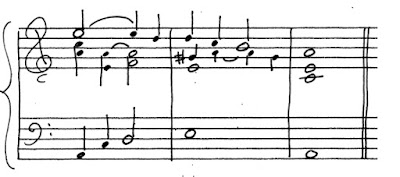Simple cadences include a 4-3 suspension over the dominant. Double cadences add a prior 6/4: see the example below (link to it on the Durante pages).
The force of the three downward resolving suspensions (9-8, 7-6, and 4-#) makes a rising motion in the cadence very difficult indeed, especially in the minor key, as here. A simple realization in four parts might look like this:
Rearranging the parts (alto becomes soprano, soprano becomes tenor) is no better from the standpoint of a rising line:
Still another version, this time in three voices, highlights the problem of the natural-^6: see the bracketed notes.
It must be said that the double cadence seems quite old-fashioned for the 18th century: it was a staple of sacred music in the 16th century (the progression above sounds far more like Palestrina than it does Corelli) and probably survived mostly because of the needs of that genre in the 18th century (which, oddly, was more conservative than it had been through much of the 17th century).
Among Durante's simple cadences is one that looks much more typical of 18th century practice: (link)
A realization of this progression makes a rising line more manageable. In three voices, it's difficult to realize the iiø6/5 -- I've left it as a simple subdominant triad in this version.
Here is another attempt, in which the correct subdominant type does appear. Putting a 6/4 on the first beat of the second bar might make for a bit smoother inner voice.
This last progression above does fit Durante's bass correctly, but neither of my two realizations quite matches figure g (reproduced below).
Here are two further versions trying to reconcile Durante's bass and figure g, again in three voices. At (a), the awkward tritone (C3 in the bass, then F#4 in the treble) is prominent, but in fact it's not an anomaly in minor-key pieces. I am more concerned about the similar motion in all parts from the D major to E major triad. At (b), that problem is solved, and the "structural alto" for many rising lines "magically" appears: ^3-^-2^1, as C4-B3-A3.








